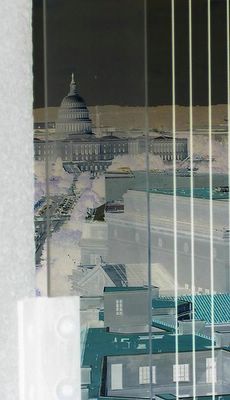ARCHITECTURE: Challenging the Horizontal City
LONDON IS EMBRACING THE SKYSCRAPER. A decade ago, there were few non-monumental buildings that made their mark on the city's skyline. London, like Washington, D.C., today, had very much a horizontal, low-rise skyline where only monumental buildings would peek out above the rooftops. But for London and other cities in the United Kingdom, the notion of the low-rise city has been changing to where residents are slowly embracing "glamorous high-rise apartment houses of wealth, power and success," writes Caroline McGhie in the Financial Times.
From the FT:
This isn't just a minor craze; it is a serious switch in the national cultural outlook.While the areas around London's City and Docklands are known for their experiments with the British capital's height regulations (look at Canary Wharf or the Sir Norman Foster's Swiss Re building at London Bridge) elevation is on the rise in other places, which is riling many folks in the capital used to the centuries of horizontality.
 Just like how that the lighted cube building near the White House (sorry, I am having trouble locating an article or a link to that building at 16th and I streets NW with the roof ornament that changes color at night) has agitated some Washingtonian purists, a nearly 50-story building -- the Vauxhall Tower, seen here -- was approved by John Prescott, the United Kingdom's deputy prime minister for planning, for a spot nearby the Houses of Parliament and caused outrage.
Just like how that the lighted cube building near the White House (sorry, I am having trouble locating an article or a link to that building at 16th and I streets NW with the roof ornament that changes color at night) has agitated some Washingtonian purists, a nearly 50-story building -- the Vauxhall Tower, seen here -- was approved by John Prescott, the United Kingdom's deputy prime minister for planning, for a spot nearby the Houses of Parliament and caused outrage.The past policy for London's planning was to spread skyscrapers out across the capital and avoid clusters of high density. But Prescott's "controversial decision rips holes through the conservatism of decades." In an increasingly crowded British capital, additional taller buildings will be making their mark on the skyline in the years to come and Londoners and residents of other cities. (Can you believe that a place like Edinburgh, Scotland, is considering how skyscrapers could fit into its ancient skyline?)
As McGhie writes:
The British, for so long huddled in terraces, wedded to front doors and lawns to mow, have belatedly discovered that vertiginous views are a good swap. Living close to the clouds in now considered thrilling and the mile-high club is the one to join.THE INTERESTING QUESTION HERE is whether Washington would ever tweak its height limit regulations to accommodate taller buildings, even if they would be just five stories taller than what's currently allowed. D.C.'s monumental skyline is a sacred one, but as every available piece of land is consumed by office or residential development in the District's core, how will the American capital accommodate its growth in the decades to come?
This also speaks to a larger issue. Washington has for decades been largely afraid to try daring and progressive architecture, satisfied to keep to buildings that are either unassuming or are a direct reflection of the city's classical revival past. As the world continues to press forward architecturally, will Washington be content to keep the status quo? Will Washington ever dare to try a different formula, or simply experiment with its current architectural equation? That doesn't mean having a skyscraper competing with the Washington Monument, but it could mean having newer structures that challenge the skyline in different and unique ways, ways we can’t even envision right now.
>> "From Rock Bottom to Sky High" [Financial Times, subsc.]



1 Comments:
London is an interesting example. That city has always been more utilitarian than continental capital cities but more concerned with European grandeur than New York, where if something's getting old, it's knocked down and replaced with something bigger. I think a willingness to go higher speaks to the economic health and vitality of a city, but there's no reason to scrap history on a whim. Rosslyn's buildings show that height can work in close proximity to downtown. My feeling is that a trapezoid should be drawn around downtown, from the Capitol to around 20th Street, and from just south of the Mall to Mass Ave, in which the height restriction remains in place. Outside that, anything goes. That would mean that commercial space in near NE and SE could develop with more density, and it would allow higher residential buildings in parts of the city, that would increase the city's tax base. Beyond the southern heights of the city, you can't see downtown anyway, so why not build up?
-Ryan A
Post a Comment
<< Home